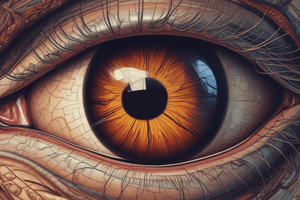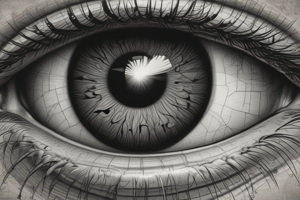Podcast
Questions and Answers
What is the purpose of the Snellen's eye chart?
What is the purpose of the Snellen's eye chart?
- To test a person's distant visual acuity (correct)
- To examine the retina
- To evaluate the shape of the cornea
- To measure the length of the eyeball
What is the definition of normal distant visual acuity?
What is the definition of normal distant visual acuity?
- The client can distinguish what the person with normal vision can distinguish from 40 ft away
- The client can distinguish what the person with normal vision can distinguish from 10 ft away
- The client can distinguish what the person with normal vision can distinguish from 30 ft away
- The client can distinguish what the person with normal vision can distinguish from 20 ft away (correct)
What is the main cause of myopia or nearsightedness?
What is the main cause of myopia or nearsightedness?
- The cornea is too curved
- The eyeball is too long (correct)
- The lens is too thick
- The eyeball is too short
What is the main cause of hyperopia or farsightedness?
What is the main cause of hyperopia or farsightedness?
What is presbyopia?
What is presbyopia?
At what age does presbyopia typically occur?
At what age does presbyopia typically occur?
What is the main cause of astigmatism?
What is the main cause of astigmatism?
What is the purpose of the Hirschberg test?
What is the purpose of the Hirschberg test?
What type of strabismus is characterized by the eye turning inward?
What type of strabismus is characterized by the eye turning inward?
What is the term for a mild weakness in eye movement that can be corrected when the eye is covered?
What is the term for a mild weakness in eye movement that can be corrected when the eye is covered?
What is the term for an oscillating or shaking movement of the eye?
What is the term for an oscillating or shaking movement of the eye?
What is the term for a condition where the visual axis of the eye is higher than the fellow fixating eye?
What is the term for a condition where the visual axis of the eye is higher than the fellow fixating eye?
What is the purpose of assessing the visual field of a person?
What is the purpose of assessing the visual field of a person?
What is the indirect/consensual reflex in the pupillary light reflex?
What is the indirect/consensual reflex in the pupillary light reflex?
What is the functional reflex that allows the eyes to focus on near objects?
What is the functional reflex that allows the eyes to focus on near objects?
What is the purpose of using Snellen's chart or E chart in a physical examination of the eye?
What is the purpose of using Snellen's chart or E chart in a physical examination of the eye?
What is the resolving power of the eyes?
What is the resolving power of the eyes?
What is the structure that produces tears?
What is the structure that produces tears?
What is the purpose of asking the client about their history of previous eye surgery?
What is the purpose of asking the client about their history of previous eye surgery?
What is the instrument used to inspect the internal eye?
What is the instrument used to inspect the internal eye?
What is the term for the inflammation of the conjunctiva?
What is the term for the inflammation of the conjunctiva?
What is the term for a drooping of the eyelid?
What is the term for a drooping of the eyelid?
What is the term for a clouding of the lens of the eye?
What is the term for a clouding of the lens of the eye?
What is the term for an inwardly turned lower eyelid?
What is the term for an inwardly turned lower eyelid?
What is the term for a protruding of the eyeball and retracted eyelids?
What is the term for a protruding of the eyeball and retracted eyelids?
What is the term for an unequal size of the pupils?
What is the term for an unequal size of the pupils?
What is the term for a stye or inflamed meibomian gland?
What is the term for a stye or inflamed meibomian gland?
What is the term for a pinkish triangular tissue growth on the cornea of the eye?
What is the term for a pinkish triangular tissue growth on the cornea of the eye?
Flashcards are hidden until you start studying
Study Notes
External Structure of the Eyes
- Extraocular muscles: responsible for eye movement
- Rods and cones: photoreceptors in the retina
- Visual field: what a person sees in one eye, divided into 4 quadrants (upper temporal, lower temporal, upper nasal, and lower nasal)
- Binocular vision: using two eyes with overlapping fields
Visual Reflexes
- Pupillary light reflex: constriction and dilatation of pupils when exposed to light
- Direct reflex: immediate constriction of pupils when exposed to bright light
- Indirect/consensual reflex: constriction of one eye when the other eye is exposed to light
Accommodation
- Functional reflex allowing the eyes to focus on near objects
Physical Examination of the Eyes
- Inspection of the external eye
- Inspection of the internal eye through ophthalmoscope
- Consider factors such as age, health-related conditions, and history of eye surgery or trauma
Factors to Consider during Examination
- Age and use of corrective lenses, artificial eye, allergies, pain, and visual disturbances
- Health-related factors such as high blood pressure, diabetes mellitus, and history of eye surgery or trauma
- Ask the client about history of previous eye surgery, trauma, use of corrective glasses or contact lenses, blurred vision, Diplopia, strabismus, recent changes in vision, date of previous vision test, allergies, eye redness, and frequent watering discharge
Structures to Inspect
- Position and alignment of eyes
- Eyebrows
- Eyelids
- Lacrimal apparatus
- Conjunctiva and sclera
- Cornea and lens
- Iris
- Pupils
Examination Techniques
- Inspection
- Palpation
- Ophthalmoscope
Equipments
- Snellen's chart/E chart
- Near vision screener/newspaper
- Penlight
- Opaque card
- Ophthalmoscope
- Disposable gloves
Visual Acuity
- Resolving power of the eyes
- Sharpness of vision
- Purpose:
- To quantify visual acuity
- To determine the severity of the impairing disorder
- To classify visual impairment, low vision, blindness
- Done by placing the client 20 feet from the Snellen's eye chart and testing each eye alone
- Normal distant visual acuity: 20/20, where the client can distinguish what a person with normal vision can distinguish from 20 feet away
Abnormalities of Refraction
- Myopia (near-sightedness): develops in eyes that focus images in front of the retina instead of on the retina, resulting in blurring of vision
- Eyeballs are too long, preventing incoming light from focusing directly on the retina
- Abnormal shape of the cornea or lens
- Hyperopia (far-sightedness): develops in eyes that focus images behind the retina instead of on the retina, resulting in blurring of vision
- Eyeballs are too short, preventing incoming light from focusing directly on the retina
- Abnormal shape of the cornea or lens
- Presbyopia: aging of the lens of the eyes, resulting in decreased accommodation
- After age 40, the lens becomes more rigid and loses its focusing ability, making it difficult to read at close range
- Astigmatism: uneven curvature of the cornea that prevents horizontal and vertical rays from focusing on the retina
- Distorted, wavy mirror
- Blurred vision at all distances
Assessing Visual Field
- Corneal light reflex test (Hirschberg test) to detect strabismus
Assessing Extraocular Muscle Function
- Corneal light reflex test (Hirschberg test) to detect strabismus
- Pseudoesotropia: normal in young children, where the pupils appear in the inner canthus
- Strabismus (tropia): constant malalignment of the eye axis
- Types:
- Esotropia: eyes turn inward
- Exotropia: eyes turn outward
- Hypertropia: visual axis of the eye is higher than the fellow fixating eye
- Hypotropia: visual axis of the eye is lower than the fellow fixating eye
- Types:
- Phoria (mild weakness): covered test, where the eye returns to normal once covered
- Paralysis strabismus
Other Abnormalities
- Nystagmus: oscillating (shaking) movement of the eye, associated with inner ear disorders, multiple sclerosis, brain lesions, or narcotics
- Ptosis: drooping of the eyelid, often due to oculomotor damage
- Ectropion: outwardly turned lower lid
- Conjunctivitis: inflammation of the conjunctiva
- Exophthalmos: protruding of the eyeballs and retracted eyelids
- Sunken eyeballs
- Chalazion: infected meibomian gland
- Stye/hordeolum: inflamed sebaceous gland
- Entropion: inwardly turned lower eyelid
- Blepharitis: staphylococcal infection of the eyelid
- Diffuse episcleritis: inflammation of the sclera
- Subconjunctival hemorrhage
- Scleral jaundice
- Corneal abnormalities:
- Pterygium: thickening of the bulbar conjunctiva that extends across the nasal side
- Cataract: clouding of the lens of the eyes
- Glaucoma: clouding of the lens caused by increased intraocular pressure that damages the optic nerve
- Lens abnormalities:
- Cataract: clouding of the lens of the eyes
- Glaucoma: clouding of the lens caused by increased intraocular pressure that damages the optic nerve
- Abnormalities of the iris and pupil:
- Coloboma: irregular shape of the iris
- Anisocoria: unequal size of pupils
- Miosis: pinpoint pupils, often due to narcotic drugs or brain damage
- Mydriasis: dilated pupils, often due to CNS injury, deep anesthesia, or certain medications
Studying That Suits You
Use AI to generate personalized quizzes and flashcards to suit your learning preferences.




